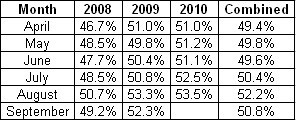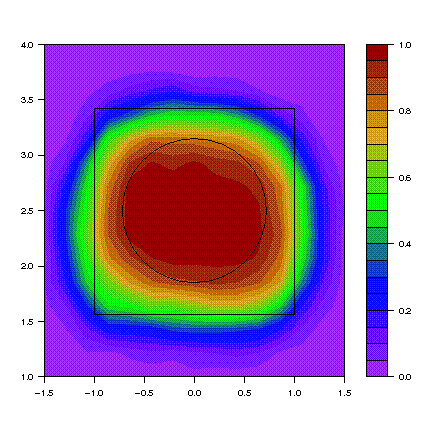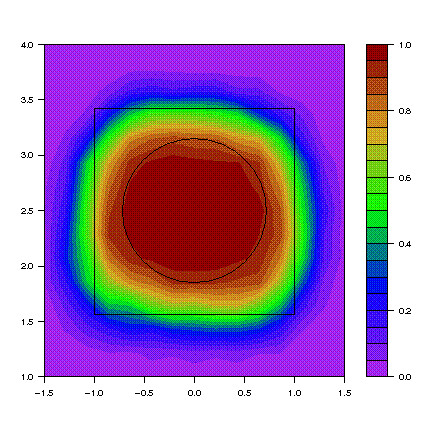Belt Closer to the Bay
It has been a good year to be a first baseman in the San Francisco Giants organization. Aubrey Huff has been one of the season’s great surprises, having his best season since he was 26 years old, a year after the worst season of his career. Huff has expressed interest in returning to San Francisco next season, and while Brian Sabean said that he has “earned consideration” for an extension, no talks have been planned. Throwing a wrench into those negotiations is surely the unbelievable season that Brandon Belt has had in the minor leagues. Promoted to Triple-A before yesterday’s games, Belt tallied a home run, two walks, a steal and three runs in his first game for the Fresno Grizzlies. Now having played across three levels, Belt is hitting .363/.464/.628 (with a .450+ wOBA) in 123 games.
Belt was an above-slot signee after being drafted in the fifth round of the 2009 draft out of the University of Texas. After transferring to the Longhorns as one of the junior college’s best players, Belt disappointed a bit in two seasons with the Longhorns, hitting .324/.405/.514 for his career. It’s a good line, but for a first baseman with aluminum bats, and considering the hype that surrounded his transfer, expectations had been higher. But credit the Giants scouting team for not judging Belt by his number output, and instead seeing a guy they could develop into an asset. After all, Belt had struck out just 72 times in 469 Division I at-bats (15.4 K%); only his power numbers disappointed.
The Giants saw something in his approach that could be changed, and for that, I’ll turn to a piece Andy Baggarly wrote for Baseball America [side note: buy a subscription!]:
When the Giants first saw Belt in instructional league last fall, he had a closed stance that served him well as a contact hitter but left him prone to hard stuff inside…”All we did was square him up and give him some direction back toward the middle,” [farm director Fred] Stanley said. “Just kind of free him up so his hips and hands can work . . . and my goodness.”
Indeed. After starting his season 0-for-8 in two games, Belt would post just nine more 0-fers in 75 games in the California League. He would put together an 18-game hit streak in April and a 16-game streak in June, flashing more power as time went on. Even his baserunning improved — after going just 11-for-18 stealing bases the first two months, Belt stole seven straight bases successfully before earning a promotion to Double-A. Belt’s Cal League career ended with a .383/.492/.628 batting line (.486 wOBA)in one of the leagues tougher stadiums in which to hit- at an age just under the league average. The team moved him up to Richmond in the Eastern League, where — according again to Fred Stanley in Baggarly’s piece — “it’s taken some of our batting hitting prospects a few months to get used to that league.”
It took Belt one game. In his Flying Squirrels debut, Belt went 0-for-3 against former first-round pick Brooks Brown. He followed that up with a 12-game hitting steak that included five home runs and six multi-hit games. With above-average speed and a strong left arm (he was once considered a stronger prospect on a mound), I was calling for an outfield trial as early as June. On July 29, the Giants responded, giving Belt a start in left field for the first time all season. In his final 23 games with Richmond, Belt would take the outfield seven times. While his defense at first base is considered an asset, adding some versatility can’t be considered a bad thing — and given the AAA Fresno Grizzlies have had Brett Pill at first base all season, Belt sure enough had his first start yesterday in left field.
According to Baggarly, “the Giants expect to call him up in September.” I’m guessing the promotion to Fresno has something to do with the fact that the Grizzlies are in a Pacific Coast League playoff hunt, while Richmond is near the bottom of the Eastern League standings. Many teams like their prospects to get some minor league postseason experience before reaching the big leagues, and I think it’s likelier we’ll see Belt in San Francisco after the Fresno season ends, rather then when the rosters expand on September 1. I think he could help the Giants against right-handed pitchers; he doesn’t have a bad line against left-handers this year, but in High-A he couldn’t hit them for power (.097 ISO), and in Double-A, his BB-K ratio was 2-12 in 53 plate appearances. He has shown some improvements this year, and I’m not calling him a future platoon player, just not a 22-year-old that should be getting development time against big league lefties in a Wild Card race.
We’ll get into Belt’s WAR potential another day, but suffice it to say, we should begin taking this breakout seriously. Belt now has 536 plate appearances with a solid strikeout rate, a great walk rate, and improving power. As Dave Cameron reminded us around the trade deadline, “In prospect land, things can change a lot in a short period of time.” This is magnified when a team combines good scouting with good developing; it’s magnified even gretaer when a player buys into instruction. Brandon Belt isn’t a future star, but he’s a reason for the Giants to re-consider paying Aubrey Huff for his big season.






